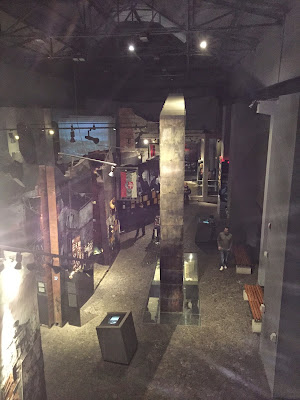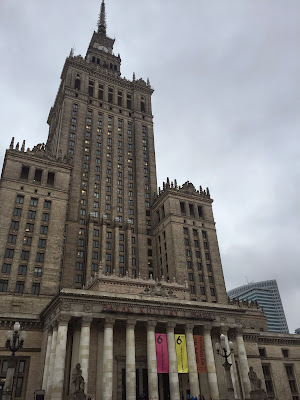There's no denying that Warsaw has had a troubled history as the city has been a prize for both European and Russian Empires as the Swedes overtook the city in the 17th century and later Russia would occupy Poland for most of the 19th century. It was after World War I that Poland once again emerged on the map and Warsaw enjoyed a golden age. The outbreak of WWII brought new suffering to Warsaw as it was occupied by Nazi Germany. Most of the Jewish population would die in the ghettos or would be killed in the gas champers of Treblinka. In 1944, with liberation in sight, the Polish population would rise up against the Nazi occupation. However, Warsaw did no receive the needed help from the West and the uprising ultimately failed. As punishment, Hitler had almost the entire city destroyed and burned to the ground. After liberation from the Nazi's, Poland was once again occupied by Russia. The city would be ruled by a communist government until 1989 when the iron wall fell.
Old Town Warsaw
The Old Town was 90% destroyed by Hitler after the uprising in 1944, yet it is impossible to tell as the city still looks like it would have looked during the Middle Ages. After the war, a five-year reconstruction campaign by its citizens resulted in today's meticulous restoration of the Old Town, with its churches, palaces and market-place.. In fact, in 1980 it was granted the status of a UNESCO World Heritage List. It truly was hard to believe that everything I was seeing was actually a new building as I felt like I was walking the streets of a very old city.
 |
| Warsaw after WWII |
 |
| Belle thought it was way too bright to take a picture |
 |
| The Palace |
 |
| The Medieval Walls |
Notice the statue of the monkey at the corner of the building. When rebuilding the city, the citizen's studied pictures and painting of the original city. To rebuild this house, a painting was used. The painter who was commissioned to paint the picture did not get along with the lady who lived in the house. As a joke, he painted a monkey gargoyle instead of what was really there. Not realizing it was a joke, the house was reconstructed with the monkey.
Can you find the tiny house that is sandwiched between the two larger houses? This was done as an attempt to pay less taxes. You may think it looks unlivable, but......
this is the same house from the back. Houses at the time were charged according to their size on the front, so this was a clever way to avoid paying taxes on a large house.
The symbol of Warsaw is the Mermaid. There are various legends about the Warsaw mermaid and how she came to represent the city. Legend says that she and her sister were swimming, when her sister grew tired and stopped at the city of Copenhagen. However, the mermaid of Warsaw was more curious and continued swimming when she reached the inlet to the river when she stopped on a riverbank near the Old Town to rest. Liking it, she decided to stay. Local fishermen noticed that something was creating waves, tangling nets, and releasing their fish. They planned to trap the offender, but fell in love with her upon hearing her singing. Later, a rich merchant trapped the mermaid and imprisoned her. Hearing her cries, the fishermen rescued her, and ever since, the mermaid, armed with a sword and a shield, has been ready to help protect the city and its residents.
After all of our exploring, Belle and I enjoyed a traditional Polish lunch.
 |
| Goat Cheese on Toast with Raspberry Dressing |
 |
| Pierogies stuffed with meat and cheese. They were delicious! |
For dessert, we stopped at a Polish candy store for hot chocolate and treats
 |
| Belle was exhausted by the end of the day |
Warsaw has many famous residents. Marie Curie was originally from Warsaw. While she became a French citizen, she never lost her Polish identity. Polonium, the first chemical element that she discovered, was named after Poland.
Another famous resident of Warsaw was the composer Chopin. Throughout the city are benches dedicated to Chopin and his life. Not only do they give you information about the composer and the artifacts that are located by the bench, but they also play music. To learn more about the composer, Cyle, Belle and I visited the Chopin museum. Chopin's heart will always be in Warsaw...literally. Upon his death, his sister had his heart removed and buried in the city that he loved.
To learn more about the Warsaw Uprising of 1944, Belle and I visited the Uprising Museum. The uprising was led by the Polish Resistance Home Army, and their goal was to liberate Warsaw from Nazi Germany. The uprising was timed to coincide with the approaching Soviet Army who were reaching the suburbs of the city. The Warsaw Uprising lasted from August 1944 to October 1944. However, the Soviet advance stopped short, enabling the Germans to regroup and demolish the city while defeating the Polish resistance, which fought for 63 days with little outside support.
 |
| A monument to the uprising |
The Polish Army used the sewer system to move undetected from the Nazis. This part of the museum was meant to mimic how they would feel moving underneath the city via the sewer system.
The symbol for the resistance was PW (as seen on the top of this building)
One of the evenings, Belle and I joined Cyle and his colleagues for dinner.
 |
| Belle enjoying the elevator ride in the hotel |
It was an interesting experience, but we were happy when it was over as the diesel fumes were starting to become overpowering.
After our tour, we ended the evening at U Fukiera. The restaurant was Belle's first Michelin rated restaurant, but she still had her favorite dinner of chicken and rice.
Our last day in Warsaw, we explored the communist side of Warsaw. We began our day at the Palace of Culture and Science, originally known as the Josef Stalin Palace of Culture and Science. The building was conceived as a gift from the Soviet people to the Polish nation, and was completed in 1955.
The building today is controversial as many see it as a sign of the Soviet domination and oppression. However, it was decided that it would be foolish to tear it down, so it is still used to this day to host a variety of events.
The view from the top (as you can see, it was not a pretty day):
 |
| Belle taking in the sights |
The square in front of the Palace of Culture and Science. During the communist days, this square was used for parades and other communist propaganda campaigns.
This was a statue in Old Town dedicated to a Polish figure. The monument was constructed during the Communist Era; therefore, the citizens had to get permission from Russia to construct the statue. The Communist officials agreed to the statue, but mandated the statue could not be taller than a statue nearby that was dedicated to a communist official. The builder complied as the statue itself is not taller, but it still hovered over the communist statue as the pedestal on which the statue was placed made it bigger than the Communist dedicated statue.
We ended our trip to Poland, which Polish jelly-filled donuts. Yum Yum!
A tour guide remarked that Warsaw is often compared to a phoenix as it has endured hardships and destruction, but is once again emerging as a modern and vibrant city. I couldn't agree more as Warsaw, despite its tumultuous history, is rebuilding to a thriving, cosmopolitan city.
This picture truly captures the history of Warsaw as the buildings tell the city's story. The middle building (a church) is an old building that survived the war. On the left, is the Palace of Culture and Science, a building from the Communist Era. On the right, is the new and upcoming Warsaw symbolized by the new and modern skyscrapers.



















































No comments:
Post a Comment